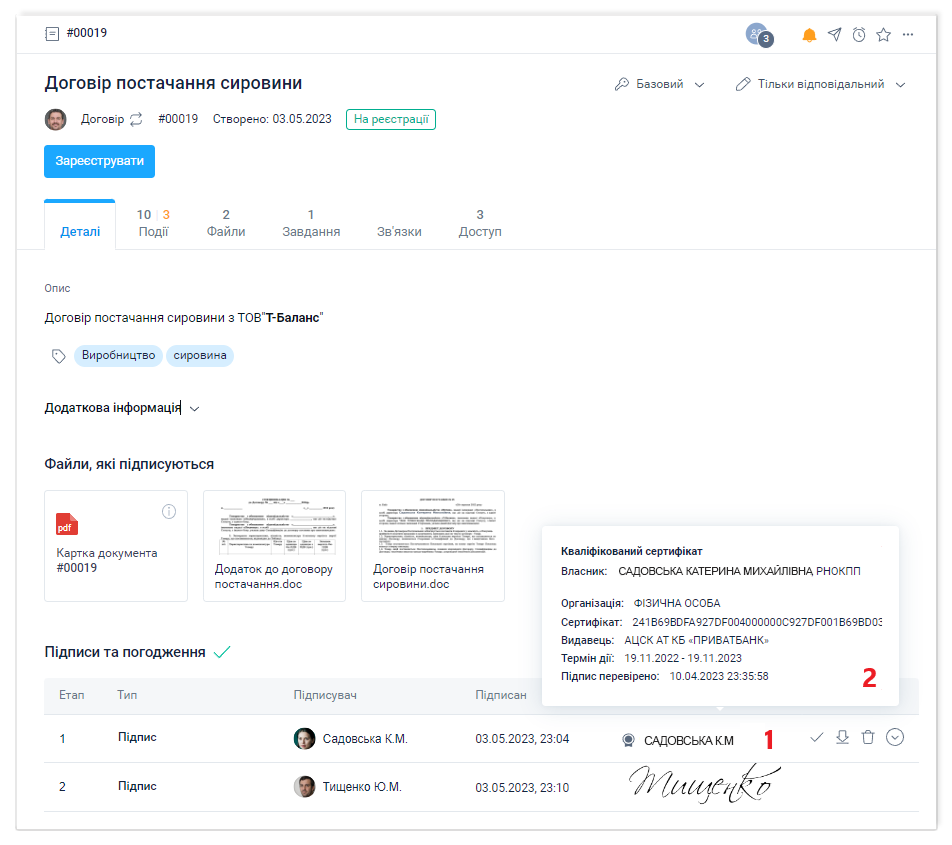
16 Mar 2025
Electronic vs. live signature. Which one should you use?
If you have ever signed a petition or confirmed a request in online banking, you already know what an electronic signature is. However, you place such a signature, even without realizing it, much more often. It doesn’t resemble your handwritten signature—not just in appearance, but also in terms of reliability and convenience. Let’s talk about the difference between a “live” signature and an electronic signature, as well as the advantages and disadvantages of each.
What is a live signature
To sign a “real” document, we usually use a ballpoint pen and leave a mark on a sheet of paper. Such a signature is called “live” because it is handwritten, meaning it is placed directly by its author.
At different times, people have also used various methods of signing documents, such as personal seals or even fingerprints. For a long time, the “live” signature was considered the only way to sign legal documents—it was deemed reliable and guaranteed that the contract would be fulfilled.
According to Professor Chris Reed, it doesn’t matter what your signature looks like—whether it’s a cross, a scribble, initials, or even your name and surname printed in block letters. A signature is not just a mark on paper, but an action that signifies intent and serves as confirmation of three important facts:
- it confirms the identity of the signer;
- it indicates access to the document;
- it indicates the signer’s agreement and acceptance of responsibility for the content of the document.
Despite the spread of electronic signatures, there are still certain legal acts, such as making a will or entering into marriage, that are considered legal only with a live signature and personal presence.
Limitations of live signatures
However, live signatures have a number of drawbacks, which are particularly noticeable in business, where dozens or hundreds of documents require approval and signatures daily.
- Manually signing a document takes a lot of time. Sending papers, time for review and signing, and return shipping—this process significantly delays important business processes that sometimes require immediate execution.
- Tracking the progress of work on a paper document and monitoring the signing progress is impossible. A document sent by mail disappears from view for a long time until the signed copy is returned.
- After placing a live signature, the document must remain unchanged—it must contain all agreed-upon pages with content known and agreed upon by the signatories. Therefore, sometimes each page must be signed or all pages of the document must be stapled together.
- A live signature requires paper. Paper documents are filed into folders, delivered by mail, packed into boxes, and stored for years. All of this is an expense that is factored into the contract price and slows down the economy.
- The storage of paper documents must be secure, yet they can easily be stolen, forged, or destroyed.
- Paper documents, even those signed with a live signature, can be deemed invalid due to doubts about the authenticity of the signature.
- Searching for paper documents is difficult, time-consuming, and inconvenient. Searching for such documents by elements of their text is fundamentally impossible.
What is an electronic signature
With the development of the internet, traditional handwritten signatures have ceased to be the only and primary means of personal identification. Electronic signatures are becoming increasingly common.
The advantages of electronic signatures include security, ease of storage, and convenience of use. Most importantly, they allow for remote document signing with just internet access.
Types of electronic signatures
According to the Law of Ukraine “On Electronic Trust Services,” electronic signatures can be:
- electronic signature;
- advanced electronic signature;
- qualified electronic signature.
Important. For a long time, only the concept of an electronic digital signature (EDS) was widespread. However, with the enactment of the aforementioned law, this concept lost its meaning. It was replaced by the concepts of electronic signature (ES), advanced electronic signature (AES), and qualified electronic signature (QES).
Electronic signature
The identification of the owner of such a signature occurs in such a way that there is a “third party” who confirms the reality of this person. For example, a 6-digit code or link is sent to the signer’s email address. Only the person who actually has access to this email can correctly enter this code.
Usually, such signatures look like a facsimile, which the owner of the signature can create in their account on an electronic platform: choose a nice font for their name and surname, upload a pre-saved signature scan file, or simply draw it on the screen.
Such signatures are used when there is a minor risk of disputing legal validity, as the issuer of the signature (the electronic platform) does not compare the owner’s passport or similar documents with them personally.
Advanced electronic signature
The advanced electronic signature is issued by a qualified provider of electronic identification services. The state maintains a register of such entities. AES is intended for use by citizens and entrepreneurs. This is the most common type of signature—over 90% of citizens use it.
The issuer of the signature (most often a bank) guarantees that the data of the key owner specified in their certificate corresponds to the data of the person identified personally and based on the documents provided by them.
Usually, these are file keys. That is, a key file that contains everything necessary for signing. When creating (generating) the key, its owner will need to come up with a password for it, because every time a signature is applied using this key, this password will need to be entered.
AES can be used:
- for user identification, for example, on government websites or bank applications;
- for signing electronic documents;
- for submitting declarations, requests, appeals, etc.
The advanced electronic signature has a medium level of trust. Its vulnerability lies in the fact that the file key can be copied as many times as desired and transferred to other individuals. If these individuals know the password to this key, they will be able to sign documents with it.
Qualified electronic signature
The difference between QES and an advanced signature is that it cannot be copied. Usually, QESs are created on secure media (USB drives).
Cloud keys also belong to QESs, as they are stored on a special secure device of the key provider (Diia, etc.).
The qualified signature has the highest level of data security. This type of electronic signature has the presumption of being handwritten, i.e., “live.” This means that its full legal equivalence to a handwritten signature does not require any proof.
This does not mean that for other types of electronic signatures, it is impossible to prove that the document was signed by this particular person. For example, by going to court. It’s just that for QES, there is no need to spend time on this.
Recently, the possibility of proving the validity of an electronic signature (not QES or AES) in court has become quite real, as Ukrainian courts have begun to apply the practice of similar disputes in civilized countries. When considering disputes, the entire body of evidence is taken into account. Thus, an unscrupulous signer cannot pretend that “it wasn’t me, and it’s not my house.”
All 3 types of electronic signatures are available to Schrift users:

Advantages of using electronic signatures
- Enhanced security and reduced risk of document forgery.
- Quick approval and signing of documents, which stimulates business economic activity.
- Simplification and acceleration of work processes: contract conclusion, internal administration, communication with clients, partners, and suppliers.
- Automated collection and storage of data on signed documents.
- The ability to view, sign, and return documents—regardless of location or time.
- Convenience in tracking, searching, using, and storing documents.
- Savings on paper, postal costs, time, and other resources.
Conclusions
- The “live,” i.e., handwritten signature, is still used in various areas of life. Sometimes it is mandatory—some documents, such as a will, simply will not have legal force without a handwritten and notarized signature.
- An electronic signature can be of three types: electronic signature, advanced electronic signature, and qualified electronic signature.
- A qualified signature is equivalent to a handwritten one.
- In case of a dispute with a counterparty regarding the legal validity of an electronic signature or an advanced signature, the court will make a decision.
- The use of electronic signatures simplifies and speeds up the work of companies, enables process automation, and saves time, money, and labor resources.








